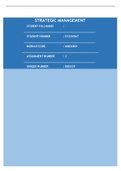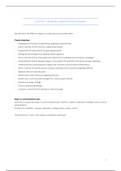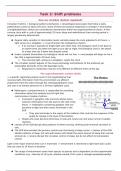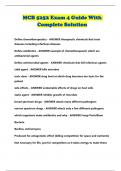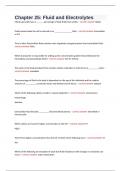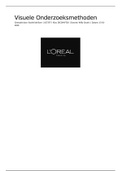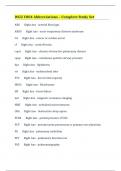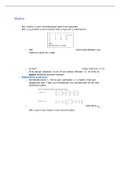Operations Management Block 4
Table of Contents
Lecture 1: Introduction, Learning and Queuing .............................................................................. 6
Introduction......................................................................................................................................... 6
Productivity ..................................................................................................................................... 6
Process design ................................................................................................................................. 7
Planning and scheduling .................................................................................................................. 7
Learning curves (Chapter 2 Module E) ................................................................................................ 8
Queuing (Chapter 2 Module D) ........................................................................................................... 9
Poisson distribution ....................................................................................................................... 10
Negative exponential distribution ................................................................................................. 10
Types of Queuing models .............................................................................................................. 10
Steps to solving a queuing exam question .................................................................................... 11
Model characteristics .................................................................................................................... 12
Model characteristics .................................................................................................................... 12
Relation between Ws and Ls (Little) .............................................................................................. 13
Relation between Wq and Ws ....................................................................................................... 13
Relation between Lq and Ls .......................................................................................................... 13
Lecture 2: Deterministic Performance Estimation ........................................................................ 14
Performance analysis ........................................................................................................................ 14
Three methods compared ............................................................................................................. 15
Deterministic performance estimation ............................................................................................. 15
Throughput time ........................................................................................................................... 16
Concepts ........................................................................................................................................ 18
Departure rate ............................................................................................................................... 19
Utilization rate ............................................................................................................................... 21
Work in progress (W.I.P) ............................................................................................................... 23
Availability ..................................................................................................................................... 25
Efficiency ....................................................................................................................................... 25
Productive utilisation rate ............................................................................................................. 25
Solving bottleneck problems ......................................................................................................... 26
Lecture 3: Inventory management
,Operations Management Block 4
.................................................................................................................................................. 27
Inventory ........................................................................................................................................... 27
Main inventory decision ................................................................................................................ 27
Advantages of inventory ............................................................................................................... 27
Disadvantages of inventory ........................................................................................................... 28
Record accuracy ............................................................................................................................ 28
Push – pull boundary (CODP) ........................................................................................................ 29
Inventory accuracy: Cycle Counting .............................................................................................. 29
ABC analysis ................................................................................................................................... 30
Control of service inventories ....................................................................................................... 30
Inventory Models – Fixed order Quantity models ............................................................................ 32
Inventory accuracy: Cycle Counting .............................................................................................. 32
Economic order quantity – EOQ .................................................................................................... 33
More EOQ calculations .................................................................................................................. 36
Production order quantity – POQ.................................................................................................. 37
Fixed Period Model........................................................................................................................ 40
Quantity discount model ............................................................................................................... 41
Inventory Models – Probabilistic models .......................................................................................... 42
Reorder points ............................................................................................................................... 43
Single-Period Model ...................................................................................................................... 46
Lecture 4: Aggregate planning; JIT, Lean, TPS .............................................................................. 48
Aggregate planning ........................................................................................................................... 48
Aggregate planning at Heineken ................................................................................................... 48
Steps in aggregate planning .......................................................................................................... 48
Planning horizons .......................................................................................................................... 49
Aggregate planning ....................................................................................................................... 49
Aggregate planning Goals.............................................................................................................. 50
Aggregate planning Goals.............................................................................................................. 50
Just in time and lean production systems ......................................................................................... 55
What is Just-in-Time? .................................................................................................................... 58
Eliminate waste ............................................................................................................................. 58
Variability occurs because: ............................................................................................................ 58
Push versus Pull control ................................................................................................................ 58
Relation between MRP and JIT ...................................................................................................... 60
Results of JIT .................................................................................................................................. 60
Inventory ....................................................................................................................................... 61
,Operations Management Block 4
SMED 3 steps ................................................................................................................................. 64
Transformation system: scheduling .................................................................................................. 65
Level schedules .............................................................................................................................. 65
Calculations of level schedule length and lot sizes ....................................................................... 65
Kanban ........................................................................................................................................... 67
Lecture 5: Process design; Capacity planning, HealthyChoice case ................................................ 68
Process design ................................................................................................................................... 69
Process strategies .......................................................................................................................... 69
Process-focused strategy............................................................................................................... 69
Product-focused strategy .............................................................................................................. 70
Repetitive-focused strategy .......................................................................................................... 71
Trade-off between volume and variety – The product-process matrix ........................................ 72
Mass customization strategy ......................................................................................................... 72
Process, Volume, and Variety ........................................................................................................ 74
Selection of equipment ................................................................................................................. 76
Process analysis and design........................................................................................................... 76
Special considerations for service process strategies ................................................................... 78
Production technology .................................................................................................................. 79
Key aspects .................................................................................................................................... 81
Customer order decoupling point: Push-pull boundary (PPB) ...................................................... 81
Process strategy and layout .......................................................................................................... 82
Process redesign ............................................................................................................................ 82
Capacity planning .............................................................................................................................. 83
Capacity considerations ................................................................................................................ 83
Matching capacity to demand ....................................................................................................... 83
Bottleneck analysis and the theory of constraints ........................................................................ 84
Approaches to capacity expansion ................................................................................................ 85
Healthy choice case ........................................................................................................................... 85
Question 1 ..................................................................................................................................... 85
Question 2 ..................................................................................................................................... 87
Crossover chart.............................................................................................................................. 89
Question 3 ..................................................................................................................................... 89
Applying investment analysis to strategy-driven investments ..................................................... 90
Lecture 6: Job design and work measurement ............................................................................. 91
Job design and work measurement .................................................................................................. 91
Human resource strategy .............................................................................................................. 91
, Operations Management Block 4
Labour Planning ............................................................................................................................. 92
Job Design...................................................................................................................................... 93
Ergonomics and the Work Environment ....................................................................................... 94
Method analysis ............................................................................................................................ 95
The visual workplace .................................................................................................................... 96
Method analysis and labour standards ......................................................................................... 97
Managing quality ............................................................................................................................. 100
3 reasons why quality is important ............................................................................................. 101
Cost of Quality (COQ) .................................................................................................................. 101
Quality gurus ............................................................................................................................... 101
TQM ............................................................................................................................................. 102
Seven concepts of TQM............................................................................................................... 102
Continuous improvement (Kaizen).............................................................................................. 102
Six Sigma Program ....................................................................................................................... 103
Employee empowerment ............................................................................................................ 103
Benchmarking .............................................................................................................................. 103
Just-in-Time ................................................................................................................................. 104
Taguchi concepts ......................................................................................................................... 104
Tools of TQM ............................................................................................................................... 105
The role of inspection .................................................................................................................. 107
TQM in services ........................................................................................................................... 107
Lecture 7: Material requirements planning ................................................................................109
Materials Requirements Planning ................................................................................................... 109
Relationship with other planning processes ............................................................................... 109
Problems with serial inventory systems and use of independent ROP techniques .................... 109
Dependent demand vs. independent demand ........................................................................... 110
Requirements for effective Use of Dependent Demand inventory models ............................... 111
The planning process ................................................................................................................... 111
Structure of the MRP system ...................................................................................................... 112
Ingredients of MRP .......................................................................................................................... 112
Bill of Materials (BoM) or Product structure ............................................................................... 112
MRP computations: notations..................................................................................................... 115
Lot-sizing techniques ................................................................................................................... 117
MRP requirements / problems .................................................................................................... 116
In practice MRP leads to (too) long lead times… inventories… costs.......................................... 118
MRP and the production planning process ..................................................................................... 119
Table of Contents
Lecture 1: Introduction, Learning and Queuing .............................................................................. 6
Introduction......................................................................................................................................... 6
Productivity ..................................................................................................................................... 6
Process design ................................................................................................................................. 7
Planning and scheduling .................................................................................................................. 7
Learning curves (Chapter 2 Module E) ................................................................................................ 8
Queuing (Chapter 2 Module D) ........................................................................................................... 9
Poisson distribution ....................................................................................................................... 10
Negative exponential distribution ................................................................................................. 10
Types of Queuing models .............................................................................................................. 10
Steps to solving a queuing exam question .................................................................................... 11
Model characteristics .................................................................................................................... 12
Model characteristics .................................................................................................................... 12
Relation between Ws and Ls (Little) .............................................................................................. 13
Relation between Wq and Ws ....................................................................................................... 13
Relation between Lq and Ls .......................................................................................................... 13
Lecture 2: Deterministic Performance Estimation ........................................................................ 14
Performance analysis ........................................................................................................................ 14
Three methods compared ............................................................................................................. 15
Deterministic performance estimation ............................................................................................. 15
Throughput time ........................................................................................................................... 16
Concepts ........................................................................................................................................ 18
Departure rate ............................................................................................................................... 19
Utilization rate ............................................................................................................................... 21
Work in progress (W.I.P) ............................................................................................................... 23
Availability ..................................................................................................................................... 25
Efficiency ....................................................................................................................................... 25
Productive utilisation rate ............................................................................................................. 25
Solving bottleneck problems ......................................................................................................... 26
Lecture 3: Inventory management
,Operations Management Block 4
.................................................................................................................................................. 27
Inventory ........................................................................................................................................... 27
Main inventory decision ................................................................................................................ 27
Advantages of inventory ............................................................................................................... 27
Disadvantages of inventory ........................................................................................................... 28
Record accuracy ............................................................................................................................ 28
Push – pull boundary (CODP) ........................................................................................................ 29
Inventory accuracy: Cycle Counting .............................................................................................. 29
ABC analysis ................................................................................................................................... 30
Control of service inventories ....................................................................................................... 30
Inventory Models – Fixed order Quantity models ............................................................................ 32
Inventory accuracy: Cycle Counting .............................................................................................. 32
Economic order quantity – EOQ .................................................................................................... 33
More EOQ calculations .................................................................................................................. 36
Production order quantity – POQ.................................................................................................. 37
Fixed Period Model........................................................................................................................ 40
Quantity discount model ............................................................................................................... 41
Inventory Models – Probabilistic models .......................................................................................... 42
Reorder points ............................................................................................................................... 43
Single-Period Model ...................................................................................................................... 46
Lecture 4: Aggregate planning; JIT, Lean, TPS .............................................................................. 48
Aggregate planning ........................................................................................................................... 48
Aggregate planning at Heineken ................................................................................................... 48
Steps in aggregate planning .......................................................................................................... 48
Planning horizons .......................................................................................................................... 49
Aggregate planning ....................................................................................................................... 49
Aggregate planning Goals.............................................................................................................. 50
Aggregate planning Goals.............................................................................................................. 50
Just in time and lean production systems ......................................................................................... 55
What is Just-in-Time? .................................................................................................................... 58
Eliminate waste ............................................................................................................................. 58
Variability occurs because: ............................................................................................................ 58
Push versus Pull control ................................................................................................................ 58
Relation between MRP and JIT ...................................................................................................... 60
Results of JIT .................................................................................................................................. 60
Inventory ....................................................................................................................................... 61
,Operations Management Block 4
SMED 3 steps ................................................................................................................................. 64
Transformation system: scheduling .................................................................................................. 65
Level schedules .............................................................................................................................. 65
Calculations of level schedule length and lot sizes ....................................................................... 65
Kanban ........................................................................................................................................... 67
Lecture 5: Process design; Capacity planning, HealthyChoice case ................................................ 68
Process design ................................................................................................................................... 69
Process strategies .......................................................................................................................... 69
Process-focused strategy............................................................................................................... 69
Product-focused strategy .............................................................................................................. 70
Repetitive-focused strategy .......................................................................................................... 71
Trade-off between volume and variety – The product-process matrix ........................................ 72
Mass customization strategy ......................................................................................................... 72
Process, Volume, and Variety ........................................................................................................ 74
Selection of equipment ................................................................................................................. 76
Process analysis and design........................................................................................................... 76
Special considerations for service process strategies ................................................................... 78
Production technology .................................................................................................................. 79
Key aspects .................................................................................................................................... 81
Customer order decoupling point: Push-pull boundary (PPB) ...................................................... 81
Process strategy and layout .......................................................................................................... 82
Process redesign ............................................................................................................................ 82
Capacity planning .............................................................................................................................. 83
Capacity considerations ................................................................................................................ 83
Matching capacity to demand ....................................................................................................... 83
Bottleneck analysis and the theory of constraints ........................................................................ 84
Approaches to capacity expansion ................................................................................................ 85
Healthy choice case ........................................................................................................................... 85
Question 1 ..................................................................................................................................... 85
Question 2 ..................................................................................................................................... 87
Crossover chart.............................................................................................................................. 89
Question 3 ..................................................................................................................................... 89
Applying investment analysis to strategy-driven investments ..................................................... 90
Lecture 6: Job design and work measurement ............................................................................. 91
Job design and work measurement .................................................................................................. 91
Human resource strategy .............................................................................................................. 91
, Operations Management Block 4
Labour Planning ............................................................................................................................. 92
Job Design...................................................................................................................................... 93
Ergonomics and the Work Environment ....................................................................................... 94
Method analysis ............................................................................................................................ 95
The visual workplace .................................................................................................................... 96
Method analysis and labour standards ......................................................................................... 97
Managing quality ............................................................................................................................. 100
3 reasons why quality is important ............................................................................................. 101
Cost of Quality (COQ) .................................................................................................................. 101
Quality gurus ............................................................................................................................... 101
TQM ............................................................................................................................................. 102
Seven concepts of TQM............................................................................................................... 102
Continuous improvement (Kaizen).............................................................................................. 102
Six Sigma Program ....................................................................................................................... 103
Employee empowerment ............................................................................................................ 103
Benchmarking .............................................................................................................................. 103
Just-in-Time ................................................................................................................................. 104
Taguchi concepts ......................................................................................................................... 104
Tools of TQM ............................................................................................................................... 105
The role of inspection .................................................................................................................. 107
TQM in services ........................................................................................................................... 107
Lecture 7: Material requirements planning ................................................................................109
Materials Requirements Planning ................................................................................................... 109
Relationship with other planning processes ............................................................................... 109
Problems with serial inventory systems and use of independent ROP techniques .................... 109
Dependent demand vs. independent demand ........................................................................... 110
Requirements for effective Use of Dependent Demand inventory models ............................... 111
The planning process ................................................................................................................... 111
Structure of the MRP system ...................................................................................................... 112
Ingredients of MRP .......................................................................................................................... 112
Bill of Materials (BoM) or Product structure ............................................................................... 112
MRP computations: notations..................................................................................................... 115
Lot-sizing techniques ................................................................................................................... 117
MRP requirements / problems .................................................................................................... 116
In practice MRP leads to (too) long lead times… inventories… costs.......................................... 118
MRP and the production planning process ..................................................................................... 119


